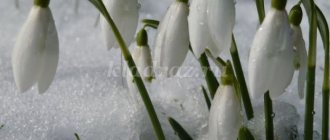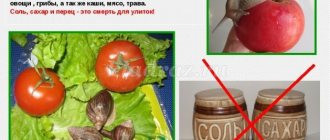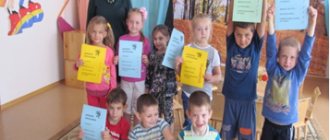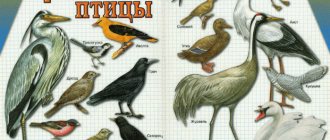Summary of educational activities for speech development in the senior group on the topic: Spring
Synopsis of the educational activity on the development of speech “Spring has come” for children of the senior group
Author: Vitskova Marina Viktorovna, teacher of the MBDOU “Kindergarten “Goldfish” of the Astrakhan region, Chernoyarsk district. This material will be useful for educators when conducting conversations and educational activities on the topic: “Spring” with children of the older group. Goal: to promote a generalization of ideas about spring as a season, about weather conditions in spring. Objectives: Deepen understanding of seasonal changes in nature; Continue to introduce children to folklore works about spring; develop logical thinking, coherent speech, enrich and activate vocabulary, develop communication skills. To cultivate responsiveness in children, to form a positive emotional attitude towards the beauty of spring nature. Materials: Pictures depicting signs and signs of spring. Preliminary work: Examination with children of illustrations about spring, spring changes in nature, conversations with children about the signs of spring, about signs. Reading fiction about spring, memorizing poems about spring, asking riddles, sayings and proverbs.
GCD
Educator. Hello guys.
Now I’ll tell you a riddle, and you guess it. Mystery.
The streams rang, the rooks flew in.
The bee brought the first honey to her hive. Who can say, who knows, When this happens? Children. In the spring Educator. Now we'll play a game.
A didactic game is being played: “Spring words”
Purpose. Practice choosing definitions for nouns. — What is the sky like in winter? Children. (Clear, gloomy, low, heavy. cold, gloomy.) What is the sky like in spring? Children. (Blue, bright, clean, spring, high, cheerful. clear.) - What kind of sun is it in spring? Children. (Bright, radiant, warm, affectionate.) What kind of grass is it in the spring? Children. (Young, green, first, tender, fragrant.) Educator. Guys, now I suggest you choose definitions for the word Spring. Spring, what is it like? Children. Spring is early, sunny, festive, rainy, long-awaited, warm, joyful. Educator. A stream in the forest laughs, And a starling sings in the garden. The sun is getting hotter, And winter is coming to an end. The first little snowdrop Awoke from sleep, He straightened his petals: - I have grown up, spring has come! Educator. Children, tell me the signs of spring? Children. The early arrival of a lark means early spring. When the blackbirds arrive, it means there will be no more frosts. If a woodpecker is seen in March, then spring will be late. If you see a starling, know: spring is on the doorstep. There are a lot of cobwebs in spring - there will be a hot summer. Educator. Guys, what spring months do you know? Children. March April May. Educator. Tell me, what proverbs and sayings about spring are you familiar with? Children. Spring is like a peahen: beauty and glory to the whole world. Spring is red and hungry. No matter how the frog pouts, it’s still far from the ox. The frog in the well does not know about the sea. There would be a swamp, but there would be frogs. Every sandpiper is great in its swamp. Even the frog sings in his swamp. Spring - the redness of winter - brings the zemstvo to nothing. One swallow does not make spring. Educator. Guys, do you like spring, and what does it do, what words can you say from it? Children. Spring is coming, coming, coming, blooming, approaching, smelling. A didactic game is being played: “Name it in one word” Goal: expand and activate vocabulary. Strengthen the skills of word formation of nouns. A flower that blooms immediately after the snow melts. Children. Snowdrop. A place where the snow melted and the earth opened up. Children. Thaw Warm weather with melting snow and ice. Children. Thaw. The first flower to appear in early spring. Children. Primrose. Falling drops of thawed snow. Children. Drops.
Physical school is being held
Spring, spring!
Spring came! Clap your hands.
She brought warmth on her wings.
Short flaps of the arms and wings
And then in the very sun,
Walking.
With your proud head raised.
Raise your chin higher.
The blue snowdrop blossomed.
Hands to the side.
He's all fluffy, silver,
Squats.
The little one stands in the sun.
Jumping.
He is a reliable messenger of spring,
tilts his torso.
He is not afraid of cold weather.
Other flowers will come after him, Turns left and right.
He is the firstborn among flowers.
Educator. Guys, what do you think Spring smells like? Children. Spring smells of freshness, flowers, grass . Educator. Now tell me what spring holidays do you know? Children. World Cat Day, March 8, World Water Day, Earth Day, Writer's Day, Laughter Day, Bird Day, Health Day, Cosmonautics Day, Spring and Labor Day, Sun Day, Victory Day, Family Day, Border Guard Day. Educator. Well done guys, did a very good job! Educator. What time of year were we talking about today? What signs and signs of spring do you remember? (Children's answers)
We recommend watching:
Summary of a comprehensive lesson in the senior group on the topic: Spring Summary of the lesson for children of the senior group. The beauty of the native land Abstract OD on a spring theme in kindergarten in the senior group. Journey to the world of spring Thematic spring music lesson in the senior group “Spring sounds and colors”
Similar articles:
Summary of a lesson on a spring topic in the senior group. Description of the painting by Savrasov “The Rooks Have Arrived”
Walking in the senior group. Card file with goals for March
Walking in the senior group. Card file with goals for April
Walking in the senior group. Card file with goals for May
MAGAZINE Preschooler.RF
Summary of a lesson on speech development in the senior group. Theme: "Spring"Tasks:
- To develop in children the ability to correctly determine the mood reflected by an artist in a landscape (I. Levitan “Spring. Big Water.” ) and by a writer in a literary work (I. Sokolov - Mikitov “Forest Pictures” ), and convey it in their story.
- Develop the ability to compose sentences and pronounce them with different intonation colors, convey joy and grief with your voice.
Materials: reproduction of I. Levitan’s painting “Spring. Big water."
Progress of educational activities:
Teacher: Children, what time of year is it now?
Children: Spring.
Teacher: Look (shows a reproduction): spring is also depicted in the painting by the artist Levitan. Isaac Levitan loved his homeland very much and painted pictures in which he depicted his native nature. This painting is called “Spring. Big water." Let's take a closer look at the picture. What did the artist depict in the picture?
Children: The artist depicted spring, a forest standing in the water.
Teacher: Why do you think the artist called the painting “Big Water” ?
Children: The artist named his painting this way because in the spring, after the snow melts, a lot of water is formed.
Teacher: That's right, the ice on the river melts, the river overflows and floods the forest. That’s why the forest in Levitan’s painting stands in the water. Do you think the artist depicted in his painting which spring - early or late?
Children: The artist depicted early spring in the picture.
Teacher: That's right, well done! Let's play a little: stand in a circle, repeat the words and perform the movements.
Physical school
Sunshine, sunshine, golden bottom,
Burn, burn clearly so that it doesn’t go out! (Children walk in a circle holding hands.)
A stream ran in the garden, (They run in a circle, one after another on their tiptoes.)
A hundred rooks have arrived (They run, flapping their arms like wings.)
And the snowdrifts melt, melt, (Slowly squat.)
And the flowers are growing. (Reach up, standing on tiptoes and raising arms.)
Now listen to an excerpt from Ivan-Sokolov Mikitov’s story “Forest Pictures” .
(Joyful, noisy and fragrant spring! Birds sing loudly, spring streams ring under the trees. The swollen buds smell like tar. A warm wind runs through the high peaks. Soon, soon the forest will be covered with leaves, bird cherry trees will bloom on the edges, vociferous nightingales will click over the streams. They will fly in, Long-tailed cuckoos will crow: “Puk-ku! Puk-ku! Puk-ku!” Busy ants run over the hummocks, the first bumblebee will fly out of their winter shelter, the first bumblebee will buzz. Shoots of young grass, blue and white snowdrops will cover the forest clearings.)
Children, what spring is the story talking about?
Children: The story talks about early spring.
Teacher: Why did you decide that the story talks about early spring?
Children: Swollen buds smell like resin. The cuckoos haven't arrived yet. The snowdrops have not yet bloomed.
Teacher: In what words does the author speak about spring?
Children: Spring is joyful, noisy, fragrant.
Teacher: How does the author describe spring?
Children: The birds are singing loudly. Spring streams are ringing. The swollen buds smell like resin. A warm wind runs through the peaks.
Teacher: Let's play the game “Say the opposite” : I will name the word, and you must choose the word that has the opposite meaning.
Game "Say the other way around"
Spring is early - late.
Spring is warm - cold.
Spring is cheerful and sad.
The wind is cold - warm.
The wind is strong - weak.
Now let’s select words that are similar in meaning to the words “spring” , “water” , “wind” .
Children: Spring, spring, freckle, stonefly. Water, watery, watery, dropsy. Wind, wind, wind, wind.
Teacher: Today we looked at Levitan’s painting “Spring” and listened to an excerpt from the story “Forest Pictures” . What do these two works have in common?
Children: Spring.
Teacher: What spring?
Children: Spring is early.
Teacher: That's right, the artist and writer depicted early spring in their works. Think and tell me, is the spring in these two works the same?
Children: No! Spring in the picture is sad, but in the story it is cheerful.
Teacher: How else do these works differ?
Children: In the picture the forest stands in the water, and in the story streams run under the trees.
Teacher: That's right, well done! Now come up with a sentence about spring and say it in such a way that it is clear: you are happy about spring. Say it joyfully and cheerfully.
Children: Spring has come, everything is in flowers!
Teacher: Now come up with a sentence about spring and say it in such a way that it is clear that spring is not always a joy. Say it with sadness.
Children: Spring has come, there is mud and water all around.
Teacher: Well done.
| Next > |
Abstract of GCD in the educational field of speech development “Spring is coming! Make way for spring!
Summary of direct educational activities
with children of senior preschool age
(preparatory group)
in the educational field "Speech development"
on the topic of:
“Spring is coming, make way for spring»
Integration of educational areas: “Cognitive development”, “Speech development”, “Socio-communicative development”, “Physical development”
Tasks:
1). To consolidate and expand children's vocabulary on the topic “Spring”.
Improve the grammatical structure of speech (formation of nouns with diminutive suffixes, agreement of nouns with adjectives).
Exercise children in the ability to talk about the seasons (spring) using visual aids, coherently, in a logical sequence.
("Speech Development")
2) To form concepts of cause-and-effect relationships and patterns in natural phenomena.
Develop children's ability to correlate iconic symbols with images.
("Cognitive Development")
3). Improve the skills of educational activities, cultivate the ability to act together, and bring the work started to completion .
To cultivate a kind attitude towards nature, to show care for it, to awaken the emotional responsiveness of children.
(Socio-communicative development")
Methods and techniques:
practical -
outdoor games, physical exercises, games. exercise;
visual
- examination of pictures, diagrams, flannelgraph
;
verbal
- conversation, riddles, questions.
Materials and equipment:
mnemonic table of the poem “Spring”, a ball, a recording of P. Tchaikovsky’s music “The Seasons”, a recording of the murmur of a brook, the singing of birds, the cartoon “How We Made Spring”, a table with empty cells, album paper, colored pencils.
Summary of GCD for the development of coherent speech
on the topic “Spring is coming, make way for spring” in the preparatory group
Integration of educational areas: “Speech development”, “Cognitive development”, “Socio-communicative development”, “Physical development”
Tasks:
1). To consolidate and expand children's vocabulary on the topic “Spring”.
Improve the grammatical structure of speech (formation of nouns with diminutive suffixes, agreement of nouns with adjectives).
Exercise children in the ability to talk about the seasons (spring) using visual aids, coherently, in a logical sequence.
("Speech Development")
2) To form concepts of cause-and-effect relationships and patterns in natural phenomena.
Develop children's ability to correlate iconic symbols with images.
("Cognitive Development")
3). Improve the skills of educational activities, cultivate the ability to act together, and bring the work started to completion .
To cultivate a kind attitude towards nature, to show care for it, to awaken the emotional responsiveness of children.
(“Socio-communicative development”)
4.) Development of motor coordination (Physical development)
Methods and techniques:
practical -
musical and rhythmic games, drawing
visual
— viewing a presentation, cartoon, working with a mnemonic table
verbal
- conversation, questions, reading poems...
Materials and equipment:
mnemonic table “Spring”, recording of P. I. Tchaikovsky’s music “Seasons”, cartoon “How we made spring”, color templates, colored pencils, bell, attribute “Lark”.
Progress of the lesson.
The children stand in a semicircle.
Educator:
Hello guys! Are you in a good mood today? Let's say hello to everyone!
- Good morning, sun! (everyone raises their hands, then lowers them).
- Good morning, sky! (similar movement).
- Good morning to all of us! (everyone spreads their arms to the sides, then lowers them).
Children sit on chairs.
Educator:
Guys, do you know what we will talk about today? Guess the riddle we have prepared for you.
| 1 child. It gets light early in the morning Thaws here and there The stream roars like a waterfall Starlings fly to the birdhouse. | 2nd child. Drops are ringing under the roofs, The bear got up from the spruce tree. The sun caresses everyone with warmth. Who knows this time? |
Children's answers.
Educator:
That's right, it's spring. Today we will talk about spring. Sit back and listen to the wonderful music composed by P. And Tchaikovsky (a fragment from the cycle “The Seasons. March” is playing) What did you see when you listened to the music? (children's answers) A very beautiful melody, it is called “March”. March is the first month of spring. People say that there are three springs: the spring of light - March, the spring of water - April, the spring of grass - May. Why do you think March is called the spring of light? (children's answers) Do you know that it is in March that brown bears wake up in their den after a long winter sleep? During hibernation, their young are born. What is the baby bear's name? (children's answers). And if there are many of them, then what do we call them? Today I will tell you about the adventures of the little bear cub Mishutka. He was just born, doesn’t know anything yet, but has already made spring. Want to know how? (children's answers) Attention to the screen.
Watching a fragment of the cartoon “How We Made Spring”
Educator:
Guys, tell me why Mishutka woke up? Who woke him up? (children's answers) Why didn't the sun wake up Mishutka in winter? How does it warm up in the spring? The sun warms brightly and tenderly. And I immediately want to say kind words to everyone.
Game: “Say kindly”: Sun-(sun), wind-(breeze), icicle-(icicle), stream-(brook), night-(night), leaf-(leaf), grass-(blade of grass), rain - (rain), snow - (snowball), puddle - (puddle) (children name words with diminutive suffixes).
Educator:
What a great fellow you are! Do you want to know what happened to Mishutka next?
View the next fragment of the cartoon “How We Made Spring” with comments from the teacher.
Educator:
Have you watched the cartoon carefully? This means we remembered all the signs of spring. Let's make sentences about spring, each sentence should begin with the word "spring" (children's answers):
For example: In spring the sun shines brightly. In spring, the first leaves and flowers appear. In spring, birds arrive from the south. In spring, birds build nests. In spring the snow melts. In spring, the ice on the rivers melts. In spring, bears and hedgehogs wake up from hibernation. In spring, streams gurgle. In spring the sun shines brighter. etc.
Educator:
Guys, please remind me with whom Mishutka spent the spring. That's right, with the sun (slide show - frame from the film). Tell me, what is the sun like in the cartoon? (bright, radiant, mischievous, cheerful, hardworking, red-haired, etc.) Let's play with the sun.
Speech game for the development of general motor skills “Caring Sun”
| The sun from the sky sends a ray, a ray, a ray. And they boldly disperse the clouds, clouds, clouds. In summer it gently warms cheeks, cheeks, cheeks. And in the spring he puts dots, dots, dots on his nose. Children's freckles turn golden. They really like it! | Children rhythmically cross their arms above their heads. Smoothly swing your arms at the top. They rub their cheeks rhythmically. Rhythmically tap your finger on your nose. |
Educator:
Why do you think April is called the spring of water? Right. Listen to another tune by P.I. Tchaikovsky, it’s called “April.” What did you hear in it? (murmur of streams, spring drops, fresh breeze, ice drift on the river)
Educator:
In spring, migratory birds return to us from warm countries. Including larks. Listen to the lark sing (recording of a lark singing). So the lark flew to us and brought an interesting game. It’s called “Lark”.
Musically
Children stand in a circle with a bell in their hand. Children walk in a circle and sing:
In the sky a lark sang and rang like a bell. He frolicked in silence, hid the song in the grass, The one who finds the song will be happy for a whole year. (“The Lark” places a bell for any player from behind).
Educator:
But spring has one more month - May, which is called the spring of grass. Why?
The music of P.I. Tchaikovsky “May” sounds.
In May it becomes very warm: the grass and trees are brightly green, insects are buzzing, butterflies are fluttering, flowers are blooming. I suggest you fill a basket with flowers for Mishutka’s mother.
Children draw flowers on pre-prepared templates.
That's how beautiful it turned out! Mishutka’s mother is already looking for her baby – a fidget. Let's see how this story ends.
Watching a fragment of the cartoon “How We Made Spring”
Educator:
The adventure of the inquisitive bear cub ended happily. We will send Mishutka's mother our basket of flowers as a gift and tell us a poem about spring that we have learned.
Children recite a poem about spring using a mnemonic table. This poem is taken from the video “Lessons from Aunt Owl”; it contains many signs of spring, which allows you to consolidate the knowledge gained and summarize the lesson.
| In March, the cold snow melts and the snowdrop blooms, awakening the forest from sleep, the beauty of spring. Mice, badgers and bear cubs wake up. The buds swell with juice to produce leaves. Birds sing joyfully in the trees here and there. Soon they will build nests to feed the chicks. Mother's Day is coming, This holiday is the most important. On this day, children all over the planet kiss their mothers. |
Educator:
Well done, you learned a lot of interesting things today, you did a good job and you can praise yourself (children pat themselves on the head and say “I did well!”)




